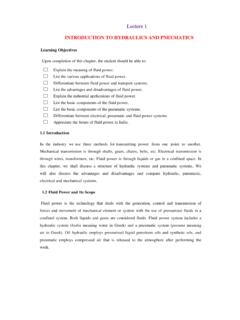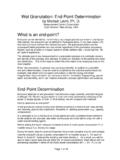Transcription of Chapter 4 Response Spectrum Method
1 102 Chapter 4 Response Spectrum Method Introduction In order to perform the seismic analysis and design of a structure to be built at a particular location, the actual time history record is required. However, it is not possible to have such records at each and every location. Further, the seismic analysis of structures cannot be carried out simply based on the peak value of the ground acceleration as the Response of the structure depend upo n the freque ncy content of ground motion and its own dynamic properties. To overcome the above difficulties, earthquake Response Spectrum is the most popular tool in the seismic analysis of structures. There are computational advantages in using the Response Spectrum Method of seismic analysis for prediction of displacements and member forces in structural systems. The Method involves the calculation of only the maximum values of the displacements and member forces in each mode of vibration using smooth design spectra that are the average of several earthquake motions.
2 This Chapter deals with Response Spectrum Method and its application to various types of the structures. The codal provisions as per IS:1893 (Part 1)-2002 code for Response Spectrum analysis o f mult i-story building is also summarized. Response Spectra Response spectra are curves plotted between maximum Response of SDOF system subjected to specified earthquake ground motion and its time period (or frequency). Response Spectrum can be interpreted as the locus of maximum Response of a SDOF system for given damping ratio. Response spectra thus helps in obtaining the peak structural responses under linear range, which can be used for obtaining lateral forces developed in structure due to earthquake thus facilitates in earthquake-resistant design of structures. Usually Response of a SDOF system is determined by time domain or frequency domain analysis, and for a given time period of system, maxi mum respo nse is picked.
3 This process is continued for all range of possible time periods of SDOF system. Fina l plot with system time period on x-axis and Response qua ntity on y-axis is the required Response spectra 103 pertaining to specified damping ratio and input ground motion. Same process is carried out with different damping ratios to obtain overall Response spectra. Consider a SDOF system subjected to earthquake acceleration, ()gxt the equation of motion is given by () () () - ()gmxtcxtkxtmx t++= ( ) Substitute 0= /km and 0 2cm = and 201d = The equation ( ) can be re-written as 200() 2() () - ()gxtxtxtx t+ + = ( ) Using Duhamel s integr al, the solut ion of SDOF system initially at rest is given by (Agr awal and Shrikhande, 2006) - ( - )00( ) - ( ) s ( - ) ttgddex txintd = ( ) The maximum displacement of the SDOF system having parameters of and 0 and subjected to specified earthquake motion, ()gxt is expressed by - ( - )0max0max( ) ( ) s ( - ) ttgddex txintd = ( )
4 The relative displacement Spectrum is defined as, d0maxS ( , )= ( )xt ( ) where 0(, )dS is the relative displacement spectra of the earthquake ground motion for the parameters of and 0. Similarly, the relative velocity Spectrum , Sv and abso lut e acceleration Response Spectrum , Sa are expressed as, v0maxS ( , )= ( )xt ( ) a0maxmaxS( , )= ()()()agx txt x t = + ( ) The pseudo velocity Response Spectrum , Spv for the system is defined as 104 pv00d0S ( , ) = S ( , ) ( ) Similarly, the pseudo acceleration Response , Spa is obtained by multiplying the Sd to 02 , thus 2pa00d0S ( , ) = S ( , ) ( ) Consider a case where 20 0 .. () () - ()gie xtxtx t =+ = max| ()()|agSxt x t= + 20 max| ( )|xt= 20max||x= 20dS= paS= ( ) The above equation implies that for an undamped system, Sa = Spa.
5 The quantity Spv is used to calculate the maximum strain energy stored in the structure expressed as 2222maxmax0111 222dpvEk xmSmS= = = ( ) The quantity Spa is related to the maximum value of base shear as 2maxmax0pa SdVkxmSm= = = ( ) The relations between different Response Spectrum quantities is shown in the Table As limiting case consider a rigid system 0 or 00T , the values of various Response spectra are 0lim0dS ( ) 0lim0vS ( ) 0maxlim( )agSxt ( ) The three spectra displacement, pseudo velocity and pseudo acceleration provide the same information on the structural Response . However, each one of them provides a physically meaningful quantity (refer equations ( ) and ( )) and therefore, all three spectra are useful in understanding the nature of an earthquake and it s influence on the design.
6 A combined plot showing all three of the spectral 105 quant it ies is possible because of the relationship that exists between these three quantities . Taking the log of equat io ns ( ) and ( ) 0logloglogpvdSS= + ( ) 0logloglogpvpaSS= ( ) From the Equations ( ) and ( ), it is clear that a plot on logarithmic scale wit h logSpv as ordinate and log 0 as abscissa, the two equations are straight lines with slopes +45 and -45 for constant values o f logSd and logSpa, respectively. This implies that the combined spectra of displacement, pseudo velocity and pseudo acceleration can be plotted in a single graph (refer Figure for combined Displacement, Velocity and Acceleration Spectrum taken from Datta, 2010). Table Response Spectrum Relationship. Relative displacement, max()xt = Sd 0vS *20aS 0 pvS= 20 paS= Relative velocit y, max()xt 0dS vS= 0aS pvS 0paS Absolute acceleration, max()axt 2*0 dS 0vS aS= 0pvS *paS (* If 0 = these relations are exact and the sign is valid up to 0 < < ) Factor Influencing Response Spectra The Response spectral values depends upon the following parameters, I) Energy release mechanism II) Epicentral distance III) Focal depth IV) Soil condit io n V) Richter magnitude VI) Damping in the system VII) Time period of the system 106 Errors in Evaluation of Response Spectrum The following errors are introduced in evaluation of Response spectra (Nigam and Jennings, 1969), 1.
7 Straight line Approximation: - In the digital computation of spectra, the actual earthquake record is replaced by linear segments between the points of digitization. This is a minor approximation provided that the length of the time intervals is much shorter than the periods of interest. 2. Truncation Error: - In general, a truncation error exists in numerical methods for integrating differential equations. For example, in third-order Runge-Kutta methods the error is proportional to ( ti)4. 3. Error Due to Rounding the Time Record: - For earthquake records digitized at irregular time intervals, the integration technique proposed in this report requires rounding of the time record and the attendant error depends on the way the rounding is done. For round-off to sec, the average error in Spectrum values is expected to be less than 2 percent.
8 4. Error Due to Discretization: - In any numerical Method of computing the spectra, the Response is obtained at a set of discrete points. Since spectral values represent maximum values of Response parameters which may not occur at these discrete points, discretization introduces an error which gives Spectrum values lower than the true values. The error will be a maximum if the maximum Response occurs exactly midway between two discrete points as shown in Figure An estimate for the upper bound of this error is shown in Table by noting that at the time of maximum displacement or velocity, the Response of the oscillator is nearly sinusoidal at a frequency equal to its natural frequency. Under this assumption the error can be related to the maximum interval of integration, ti and the period of the oscillator as shown in Figure Figure Error in Response spectra due discret izatio n.
9 Actual Maximum Value t Time, t T Response quantity 2t Recorded Maximum Value 107 Table Variation of Percentage error in Response quantity with time step chosen. it Maximum Error (%) T/10 T/20 T/40 108 Response Spectra of El-Centro-1940 Earthquake Ground Motion The Response spectra of the El-Centro, 1940 earthquake ground motion are computed using the exact Method described in the earlier Chapter (refer Appendix-I, for digitized values of the earthquake). The spectra are plotted for the three damping ratios = , and The displacement, velocity and acceleration spectra are shown in the Figures , and , respectively. Further, comparison of the real and pseudo spectra for velocity and acceleration Response is shown in the Figure As expected, there is no difference between real and pseudo absolute acceleration Response spectra. However, the velocity Response spectra may have some difference.
10 The digitized values of the Response spectra Sd, Sv and Sa of the El-Centro, 1940 earthquake is given in the Appe ndix II at an interval of sec time period for damping ratio of 2% and 5%. Figure Displacement Response spectra of El-Centro, 1940 earthquake ground motion. 109 Figure Velocity Response spectra of El-Centro, 1940 earthquake ground motion. Figure Acceleration Response spectra of El-Centro, 1940 earthquake ground motion. 110 Figure Comparison of real and pseudo velocity and acceleration Response spectra of El-Centro, 1940 earthquake ground motion (damping ratio= ). 111 Numerical Examples Example Consider a SDOF system with mass, m = 2 103 kg, stiffness, k = 60 kN/m and damping, c = Using the Response spectra of El-Centro, 1940 earthquake, compute (a) Maximum relative displacement, (b) Maximum base shear and (c) Maximum strain energy.
















